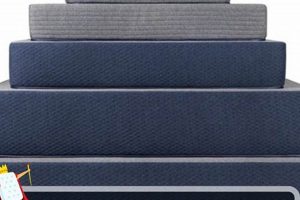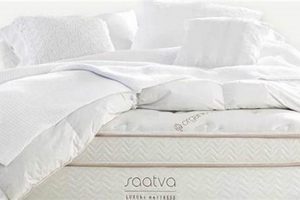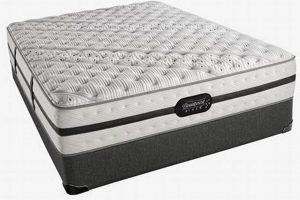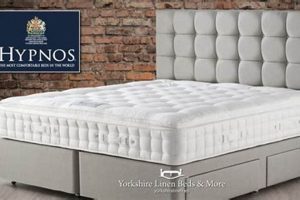The selection of a suitable sleep surface is paramount for individuals experiencing discomfort in the cervical and lumbar regions. A properly chosen mattress can offer targeted support and pressure relief, facilitating spinal alignment and reducing strain on muscles and joints. For example, a mattress that contours to the body’s natural curves can minimize pressure points, thereby alleviating pain and promoting restful sleep.
Addressing musculoskeletal pain through appropriate sleep support offers several benefits. Consistent spinal alignment during sleep can contribute to improved posture and reduced pain intensity over time. Furthermore, a well-supported sleep environment enhances sleep quality, promoting physical recovery and overall well-being. Historically, individuals have sought various materials and designs to optimize sleep comfort, ranging from rudimentary straw beds to increasingly sophisticated modern mattresses.
The subsequent sections will delve into the key considerations for selecting a mattress optimized for musculoskeletal health. This includes examining mattress types, materials, firmness levels, and other features that contribute to effective pain management during sleep.
Selecting an Optimal Sleep Surface for Spinal Health
The selection of a mattress to mitigate neck and back discomfort requires careful consideration of several factors. The following recommendations are intended to guide individuals toward a sleep surface that promotes spinal alignment and pressure relief.
Tip 1: Prioritize Spinal Alignment: A mattress should maintain the natural curvature of the spine. Side sleepers should ensure their spine is parallel to the sleep surface, while back sleepers should maintain proper lumbar support.
Tip 2: Consider Mattress Type: Innerspring, memory foam, latex, and hybrid mattresses each offer distinct support characteristics. Memory foam conforms to the body, while latex provides a more responsive feel. Innerspring mattresses offer traditional support, and hybrids combine multiple materials for balanced performance.
Tip 3: Evaluate Firmness Level: Firmness is subjective, but generally, medium-firm mattresses are suitable for many individuals with back pain. However, heavier individuals may require a firmer mattress, while lighter individuals may benefit from a softer surface.
Tip 4: Assess Pressure Relief: A mattress should distribute weight evenly to minimize pressure points, particularly in the shoulders, hips, and lower back. Pressure mapping technology can be helpful in evaluating a mattress’s pressure relief capabilities.
Tip 5: Research Material Quality and Durability: High-quality materials contribute to a mattress’s longevity and performance. Certifications such as CertiPUR-US indicate that the foam has been tested for harmful substances.
Tip 6: Consider Adjustable Bases: An adjustable bed base allows for customized positioning, which can further alleviate pressure on the spine and promote comfort.
Tip 7: Pay Attention to Edge Support: Strong edge support prevents the feeling of rolling off the mattress and provides a stable surface for sitting on the edge of the bed.
Adhering to these guidelines can significantly improve sleep quality and reduce pain associated with musculoskeletal conditions. A supportive and comfortable mattress is an investment in long-term spinal health and overall well-being.
The subsequent sections will provide detailed information regarding specific mattress types and materials, allowing for informed decision-making when selecting a mattress for pain relief.
1. Spinal Alignment
Spinal alignment represents a foundational element in the context of selecting a mattress intended to alleviate neck and back discomfort. A mattress that fails to maintain the natural curvature of the spine can exacerbate existing pain conditions and potentially lead to new musculoskeletal issues. The human spine, when viewed laterally, exhibits a series of gentle curves that distribute weight and absorb impact during movement. A supportive sleep surface should conform to these curves, preventing excessive pressure on specific areas and ensuring that the spine remains in a neutral position throughout the night.
The implications of inadequate spinal alignment are diverse. For example, a mattress that is too soft may cause the hips to sink excessively, leading to lower back strain. Conversely, a mattress that is too firm may fail to provide adequate cushioning for the shoulders and hips in side sleepers, resulting in pressure points and discomfort. Consequently, the choice of mattress firmness must be carefully considered based on individual body type, sleeping position, and any pre-existing musculoskeletal conditions. Individuals who suffer from scoliosis or other spinal deformities may require specialized mattresses or adjustable bed systems to achieve optimal spinal alignment during sleep.
In summary, spinal alignment is not merely a desirable feature in a mattress; it is a critical factor in mitigating neck and back pain. Selecting a mattress that promotes proper alignment can contribute significantly to improved sleep quality, reduced pain levels, and enhanced overall well-being. Further research into specific mattress types and materials can provide additional insights into achieving optimal spinal support during sleep.
2. Pressure Relief
Pressure relief is a fundamental attribute of a mattress designed to alleviate neck and back pain. Effective pressure relief minimizes concentrated stress on specific areas of the body, promoting blood circulation and reducing discomfort. This attribute is particularly relevant for individuals with chronic pain conditions, as it directly addresses a primary source of nocturnal discomfort.
- Contouring and Conformability
A mattress’s ability to contour to the body’s unique shape is paramount for pressure relief. Materials such as memory foam and latex excel in this regard, conforming to the sleeper’s curves and distributing weight more evenly. This reduces pressure points, particularly in the shoulders, hips, and spine, which are common areas of discomfort for those with neck and back pain. For example, a side sleeper with a pressure-relieving mattress will experience less compression on their shoulder and hip compared to a firmer, less conforming surface.
- Material Density and Responsiveness
The density and responsiveness of the mattress material also contribute to pressure relief. Higher-density materials generally offer greater support and durability, while responsive materials quickly adapt to changes in pressure. A responsive memory foam, for instance, will compress under pressure and then quickly return to its original shape when the pressure is removed. This dynamic adjustment helps to mai
ntain consistent support and prevent the buildup of pressure points. Conversely, a low-density or non-responsive material may compress unevenly, leading to pressure concentrations. - Zoned Support Systems
Some mattresses incorporate zoned support systems, which feature varying levels of firmness in different areas of the mattress. This is designed to provide targeted support and pressure relief to specific regions of the body. For example, a mattress may have a softer zone for the shoulders to allow for greater compression and pressure relief, while a firmer zone supports the lower back. This tailored approach can be particularly beneficial for individuals with specific areas of pain or discomfort.
Effective pressure relief is a cornerstone of a sleep surface designed to alleviate neck and back pain. By contouring to the body, utilizing responsive materials, and incorporating zoned support systems, mattresses can significantly reduce pressure points and promote a more comfortable and restorative sleep experience. Prioritizing pressure relief when selecting a mattress is essential for individuals seeking to manage and minimize pain during sleep. The optimal level of pressure relief varies depending on individual preferences, sleeping positions, and specific pain conditions; therefore, thorough research and testing are recommended to determine the most suitable mattress.
3. Firmness Level
Firmness level constitutes a critical determinant in selecting a mattress designed to mitigate neck and back pain. The appropriateness of a given firmness level depends on individual body weight, sleeping position, and specific pain conditions. A mattress with inadequate firmness may fail to provide sufficient support, leading to spinal misalignment and exacerbated pain. Conversely, a mattress that is excessively firm may create pressure points, resulting in discomfort and restricted blood flow. Therefore, a balanced approach to firmness selection is paramount.
The relationship between firmness level and spinal alignment is particularly significant. For side sleepers, a medium-firm mattress often proves beneficial, allowing the shoulders and hips to sink slightly while maintaining proper spinal alignment. Back sleepers may find a slightly firmer mattress more suitable, providing adequate support for the lumbar region. Stomach sleepers generally require a firmer mattress to prevent excessive sinking of the midsection, which can lead to lower back strain. Body weight further influences the optimal firmness level; heavier individuals typically require firmer mattresses to prevent excessive compression, while lighter individuals may benefit from softer surfaces that provide greater contouring. For instance, a 250-pound individual may experience inadequate support on a plush mattress, whereas a 120-pound individual may find a firm mattress excessively rigid. Understanding these interplay factors is crucial for finding a mattress that effectively reduces pain.
In summary, firmness level plays a pivotal role in determining the effectiveness of a mattress for managing neck and back pain. The ideal firmness is contingent upon individual characteristics such as body weight and sleeping position, with the ultimate goal of maintaining spinal alignment and minimizing pressure points. Selecting the correct firmness is an essential step in optimizing sleep quality and reducing musculoskeletal discomfort. Therefore, careful consideration and, ideally, in-person testing are recommended to identify the most suitable firmness level for individual needs.
4. Material Quality
Material quality is a foundational element in determining the effectiveness of a mattress for alleviating neck and back pain. The composition of a mattress directly impacts its durability, support characteristics, and potential for off-gassing. Inferior materials may degrade rapidly, leading to a loss of support and the development of uncomfortable pressure points, thereby negating any initial benefits. The choice of materials such as foam density, coil gauge, and fabric weave significantly influences the mattress’s ability to maintain spinal alignment and provide consistent comfort over its lifespan. For example, a low-density memory foam may compress excessively over time, resulting in a saggy mattress that contributes to back pain, while high-density foam retains its shape and support for a longer period.
Furthermore, material composition can affect the mattress’s temperature regulation and potential for allergenic reactions. Natural materials such as latex and organic cotton often offer superior breathability compared to synthetic alternatives, reducing the risk of overheating during sleep. Additionally, certifications like OEKO-TEX and CertiPUR-US indicate that materials have been tested for harmful substances, minimizing the likelihood of off-gassing and allergic sensitivities. Individuals with chemical sensitivities or allergies should prioritize mattresses constructed from certified hypoallergenic materials to avoid adverse reactions. The sourcing of materials, including whether they are sustainably harvested or ethically produced, also contributes to the overall quality and environmental impact of the mattress.
In summary, material quality is an indispensable component of a mattress designed to mitigate neck and back pain. The choice of materials affects not only the mattress’s immediate comfort but also its long-term durability, support characteristics, and potential health impacts. Prioritizing mattresses constructed from high-quality, certified materials is essential for ensuring a supportive and healthy sleep environment. While initial cost considerations may influence purchasing decisions, the long-term benefits of a durable and supportive mattress far outweigh the potential savings associated with inferior products, making material quality a paramount consideration for those seeking relief from neck and back pain.
5. Mattress Type
Mattress type significantly influences the suitability of a sleep surface for individuals experiencing neck and back pain. The internal construction and materials used in different mattress types provide varying degrees of support, pressure relief, and spinal alignment, directly impacting the severity of discomfort experienced during sleep.
- Memory Foam Mattresses
Memory foam mattresses conform closely to the body’s contours, distributing weight and minimizing pressure points. This characteristic can be beneficial for individuals with chronic pain, as it reduces stress on sensitive areas. However, the density of the foam and its ability to dissipate heat should be considered, as some memory foam mattresses can trap heat and lead to discomfort. The slow response time of traditional memory foam may also be a concern for individuals who change positions frequently during sleep.
- Innerspring Mattresses
Innerspring mattresses utilize a coil system to provide support. The gauge and arrangement of the coils affect the firmness and responsiveness of the mattress. While innerspring mattresses can offer robust support, they may not conform as closely to the body as memory foam or latex options. Individuals with back pain may benefit from innersprin
g mattresses with individually wrapped coils, which reduce motion transfer and provide more targeted support. - Latex Mattresses
Latex mattresses offer a combination of support and responsiveness. Natural latex is derived from rubber trees and provides a more buoyant feel compared to memory foam. Latex mattresses are known for their durability and breathability, making them a suitable option for individuals who tend to overheat during sleep. The consistent support provided by latex can help maintain spinal alignment and reduce back pain. Dunlop and Talalay are different processing methods that affect the density and feel of the latex.
- Hybrid Mattresses
Hybrid mattresses combine elements of different mattress types, such as innerspring coils with a memory foam or latex comfort layer. This design aims to provide a balance of support, pressure relief, and responsiveness. Hybrid mattresses can be a versatile option for individuals seeking the benefits of multiple mattress types in a single product. The specific combination of materials and construction techniques will determine the overall feel and performance of the hybrid mattress.
The selection of a mattress type should be based on individual needs and preferences, considering factors such as body weight, sleeping position, and specific pain conditions. Each mattress type offers distinct advantages and disadvantages, and careful evaluation is necessary to determine the most suitable option for alleviating neck and back pain. Furthermore, the quality of materials and construction techniques employed in each mattress type will influence its long-term durability and performance.
6. Edge Support
Edge support is a critical, albeit often overlooked, attribute of a mattress intended for individuals seeking relief from neck and back pain. It directly affects the usable sleep surface, ease of ingress and egress from the bed, and the overall stability of the mattress, all of which can contribute to or alleviate musculoskeletal discomfort.
- Maximizing Usable Sleep Surface
Strong edge support expands the usable surface area of the mattress. Mattresses with weak edges tend to compress significantly when weight is applied near the perimeter, creating a sloping effect. This reduces the available space for comfortable sleep, potentially forcing individuals to adopt compromised sleeping positions that exacerbate neck and back pain. For example, if a couple shares a bed, inadequate edge support may cause one or both individuals to gravitate towards the center of the mattress, leading to restricted movement and potential discomfort.
- Facilitating Ease of Movement
Robust edge support simplifies the process of getting in and out of bed. Individuals with mobility issues, including those experiencing neck or back pain, often rely on the mattress edge for leverage and stability when transitioning from a seated or lying position. A mattress with weak edges can make these movements difficult and potentially unsafe, increasing the risk of falls or further injury. A stable edge allows for a controlled and supported transfer, minimizing strain on the musculoskeletal system.
- Enhancing Mattress Longevity
Adequate edge support contributes to the overall durability and lifespan of the mattress. Consistent pressure applied to the edges of a mattress without proper support can lead to premature sagging and breakdown of the internal structure. This degradation not only reduces the comfort and support provided by the mattress but also necessitates more frequent replacement, representing an additional financial burden. A mattress with reinforced edges maintains its structural integrity over time, ensuring consistent support and preventing the development of uneven surfaces that can contribute to pain.
- Promoting Proper Posture While Sitting
Many individuals sit on the edge of their bed for various activities, such as dressing or reading. A mattress with sufficient edge support provides a stable and level surface for these activities, promoting proper posture and reducing strain on the spine. In contrast, sitting on the edge of a mattress with weak support can cause the spine to curve unnaturally, leading to discomfort and potential long-term musculoskeletal issues. A firm and supportive edge allows for a more upright and ergonomic sitting position.
In conclusion, edge support is an integral component of a mattress designed to address neck and back pain. By maximizing the usable sleep surface, facilitating ease of movement, enhancing mattress longevity, and promoting proper posture while sitting, strong edge support contributes significantly to overall comfort, safety, and spinal health. Therefore, when selecting a mattress, individuals should carefully assess the quality of edge support to ensure a supportive and stable sleep environment.
Frequently Asked Questions
The following section addresses common inquiries regarding the selection of a mattress to mitigate neck and back discomfort. The information provided is intended to offer clarity and guidance in making an informed purchasing decision.
Question 1: How does mattress firmness relate to back pain?
Mattress firmness significantly impacts spinal alignment. An improperly firm mattress may fail to provide adequate support or pressure relief, exacerbating back pain. The optimal firmness depends on individual sleeping position, body weight, and specific pain conditions. A balanced approach, considering these factors, is essential.
Question 2: What mattress type is generally recommended for neck and back pain?
There is no single “best” mattress type for all individuals. Memory foam, latex, innerspring, and hybrid mattresses each offer distinct advantages. Memory foam conforms closely to the body, while latex provides a more responsive feel. Innerspring mattresses offer traditional support, and hybrids combine materials for balanced performance. Individual needs and preferences should dictate the selection.
Question 3: How important is spinal alignment when selecting a mattress?
Spinal alignment is paramount. A mattress should maintain the natural curvature of the spine, preventing excessive pressure on specific areas. Side sleepers should ensure their spine is parallel to the sleep surface, while back sleepers should maintain proper lumbar support. Failure to achieve proper alignment can worsen existing pain conditions.
Question 4: What role does material quality play in mattress effectiveness?
Material quality significantly impacts mattress durability, support characteristics, and potential for off-gassing. Inferior materials may degrade rapidly, leading to a loss of support and the development of uncomfortable pressure points. Certifications such as OEKO-TEX and CertiPUR-US indicate that materials have been tested for harmful substances.
Question 5: Is edge support a relevant factor when choosing a mattress?
Edge support is crucial. Strong edge support expands the usable sleep surface, facilitates ease of movement in and out of bed, and contributes to overall mattress stability. Inadequate edge support can lead to compromised sleeping positions and an increased risk of falls.
Question 6: Can an adjustable bed frame improve sleep quality for individuals with back pain?
An adjustable bed frame may offer benefits by allowing customized positioning. Elevating the head or legs can allevia
te pressure on the spine and promote comfort. However, the effectiveness of an adjustable bed frame depends on the underlying mattress and individual needs.
Prioritizing spinal alignment, pressure relief, material quality, and edge support is essential when selecting a mattress. Individual needs and preferences should guide the final decision.
The subsequent section will provide a summary of the key considerations discussed throughout this article.
Conclusion
The preceding exploration has illuminated key considerations for selecting a sleep surface conducive to mitigating neck and back pain. Prioritizing spinal alignment, pressure relief, appropriate firmness levels, high-quality materials, suitable mattress type, and adequate edge support constitutes a comprehensive approach to optimizing sleep quality and minimizing musculoskeletal discomfort. The interplay of these factors dictates the effectiveness of a mattress in promoting restorative sleep and reducing pain.
Given the significant impact of sleep quality on overall well-being, the selection of a mattress designed to address neck and back pain represents a critical investment in long-term health. Further research and consultation with healthcare professionals may provide additional guidance in tailoring mattress selection to individual needs, ultimately facilitating improved spinal health and a more restful sleep experience.






![Top Rated Best Feather and Down Mattress Toppers - [Year] Guide Organic & Natural Mattress Buyer’s Guide: Non-Toxic Sleep Solutions Top Rated Best Feather and Down Mattress Toppers - [Year] Guide | Organic & Natural Mattress Buyer’s Guide: Non-Toxic Sleep Solutions](https://mattressworldpa.com/wp-content/uploads/2025/07/th-7652-300x200.jpg)
